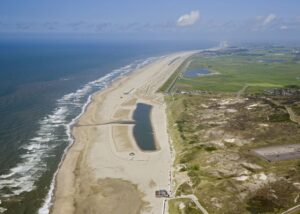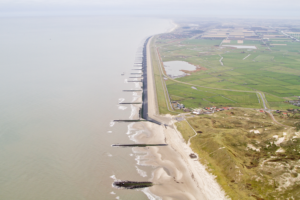Overview
The Hondsbossche and Pettemer sea dike no longer met current safety standards. Therefore the dike was reinforced in 2015 with a soft, natural barrier of 30 million cubic metres of sand on the seaside of the dike. It was renamed ‘Hondsbossche Dunes’. The construction presented the unique opportunity to study the development of dunes and nature following a large sand nourishment.
Location: Coastline between Camperduin and Petten (NL)
Date: 2014-2015 (construction), 2015-2018 (monitoring and innovation research project)
Involved parties: Waterboard Hollands Noorderkwartier, Rijkswaterstaat, Ecoshape (HKV, Witteveen en Bos, WUR, Arcadis and Deltares)
Technology Readiness Level: 9 – actual system proven in operational environment
Environment: Sandy coasts
Keywords: Constructed dune area, dune lake, sand nourishment, innovation research project, habitat development, sand transport.

Using a soft, natural barrier of sand dunes to protect the hinterland from flooding. Sand nourishment techniques are used to construct a new dune landscape that also serves natural values and recreation.

The traditional solution to an eroding coast is a basalt dike, possibly with groynes. Although the dike does provide some ecological benefits (e.g. food provision for birds), the design leads to increased erosion of the sea bed just in front of the dike. As a result, frequent maintenance is needed to meet the set safety standards.
The design consists of a soft shallow foreshore (the beach) and a varied artificial dune landscape that has the potential to develop in valuable Nature 2000 habitats. Together, these connected systems make up the primary flood defence and provide the desired spatial quality. The Ecoshape innovation project, is a three-year interdisciplinary study of the area focussing on the development and perception of nature and the morphological development of the area. The aim of the innovation project is to learn more about efficient sand-nourishment with added value for nature and leisure. The research programme includes three themes:
A. Predictability in the development of engineered habitats
B. Optimizing design and morphological evolution
C. Perception of local community and visitors
An improved understanding of these issues is crucial to the elaboration of an evaluation framework for decision-making about sandy solutions to coastal fortifications. The project also offers a clearer picture of the possibilities for the design, management and maintenance of these sandy structures.
